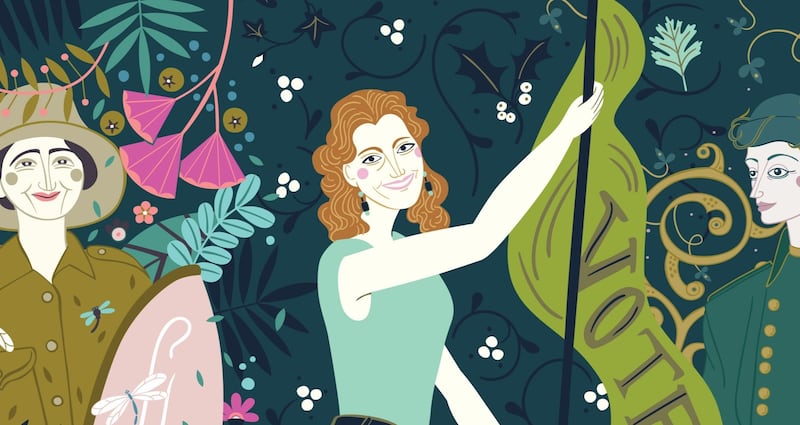Louisa Bennett (1870-1956), suffragist, trade unionist and peace activist, was born on January 7th, 1870, on Garville Avenue in Rathgar, Dublin, the eldest daughter of James Cavendish Bennett, a prosperous auctioneer, and his wife Susan (nee Bolger). The young Louie, as she was known, was brought up at Temple Hill in Blackrock, Co Dublin, and educated at Alexandra College, and an academy for young ladies in London, where she and her sisters formed an Irish League; she went on to study singing in Bonn, Germany. As a teenager she showed an interest in writing, her first literary effort being Memoirs of the Temple Road in the 1880s; she afterwards published two unsuccessful romantic novels, The Proving of Priscilla in 1902 and A Prisoner of his Word in 1908, the latter set in Co Down in the aftermath of the 1798 Rebellion.
She turned her attention to women's issues and by 1910 had become involved in the suffrage movement, initially through her reading of the suffrage monthly Irish Citizen. In 1911 she cofounded, with her life-long friend and colleague Helen Chenevix , the Irishwomen's Suffrage Federation, an umbrella organisation, which by 1913 had connected 15 Irish suffrage societies and established links with Europe and the United States. She and Chenevix were the organisation's first honorary secretaries. She was also associated with the Irish Women's Franchise League, for which she ran public-speaking classes. However, as the divide between militants and opponents of the use of violence became more pronounced, Bennett, as a confirmed pacifist, who endorsed what she called "constructive, rather than destructive action", distanced herself from the league, and through her involvement in the production of the Irish Citizen sought to sideline the militants.
Bennett, as a confirmed pacifist, endorsed what she called 'constructive, rather than destructive action' and sought to sideline the militants

Bennett's concerns were not limited to the question of women's franchise. As founder of the Irish Women's Reform League, she not only addressed the suffrage question, but examined many social issues concerning women. The league focused on working conditions, monitored court cases involving women, and demanded school meals and better education. She was among those who assisted in the relief effort at Liberty Hall during the 1913 strike and lockout in Dublin, and she appealed for funds for strikers' families through the Irish Citizen.
In the period that followed, she maintained links with the labour movement. She often opposed the direct, uncompromising approach of both James Connolly and Helena Molony, and argued that labour and women's issues would be hampered by any affiliation with nationalist politics. The aftermath of the Easter Rising and, in particular, the murder of Francis Sheehy Skeffington caused her to revise some of her views on nationalism. In late 1916 she accepted an invitation to reorganise the Irish Women Workers' Union, on the understanding that she would have complete independence from Liberty Hall. Assisted by Chenevix and Fr John Flanagan, she re-created the union along professional lines, and by 1918 its membership had risen dramatically from a few hundred to 5,300. She consistently defended its separatist stance, arguing that women's concerns in a male-dominated union would always be of secondary importance.
Throughout the first World War, Bennett campaigned for peace, and she was selected as the Irish representative to the Women’s International League for Peace and Freedom. She led the Irish Women Workers’ Union in its opposition to the attempted introduction of conscription in 1918, and in 1920 she travelled to the US to highlight atrocities committed by the Black and Tans. She later met Lloyd George and demanded the removal of the Black and Tans from Ireland. As a member of the Women’s Peace Committee, she acted as a mediator during the civil war.
She was a member of the national executive of the Irish Trades Union Congress and became the first woman president
In 1925 she was appointed to an Irish Trades Union Congress committee to promote a scheme of working-class education with the assistance of the labour movement; her interest in adult education later led to her involvement with the People's College. She was a member of the national executive of the Irish Trades Union Congress from 1927 to 1932, when she became the first woman president, and from 1944 to 1950, serving a second presidential term in 1947. Her knowledge of labour issues was officially acknowledged by the Irish government in 1932, when she was sent as a representative to Geneva to put forward the case of Irish women workers. In 1938 she delivered a paper entitled Industrialism in an Agrarian Country to the International Relations Institute in the Netherlands.
Despite the depth of her involvement with the union movement, she had ambitions outside trade unionism, and in 1938 she let her name be put forward by the Irish Women Workers’ Union as a congress candidate for election to the senate, but this came to nothing. In that year she was appointed to the government commission on vocational organisation which continued until 1943. That year she was elected as a Labour Party member of the Dún Laoghaire borough council.
As a councillor she consistently lobbied for improved housing and was instrumental in the establishment of Dún Laoghaire’s housing council in 1949. She had refused a Labour nomination in the 1918 general election, but she stood for Dublin County Council and the Dáil in 1944, in both cases unsuccessfully. She was the only Labour Party member to criticise the party’s support for the Fianna Fáil minority government of 1932, arguing that it is “never right or wise to co-operate with another party with fundamentally different principles”. As an elected member of the Labour Party executive, she represented Ireland at the International Labour Organization in Europe. She was also a representative at the League of Nations.
Throughout her public career, Bennett consistently condemned colonialism, fascism, and armaments expenditure. She is possibly best remembered for her leadership in the laundry workers’ strike of 1945, during which Irish Women Workers’ Union members successfully fought for a fortnight’s paid holiday. Her management of the union, which lasted until 1955, was marked by determination and diplomacy, though she often used threatened resignations as a means of controlling her colleagues. She died, unmarried, on November 25th, 1956, in Killiney, Co Dublin.
From the Royal Irish Academy Dictionary of Irish Biography, published by Cambridge University Press








